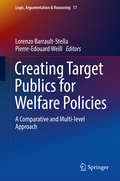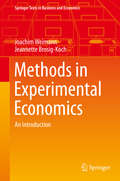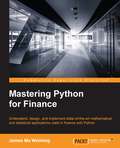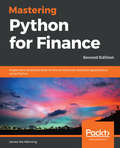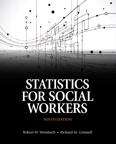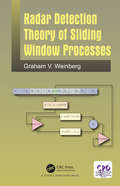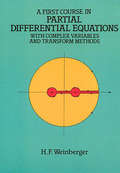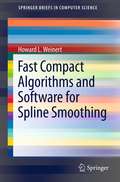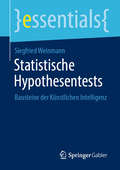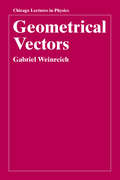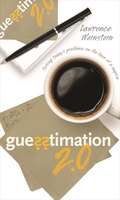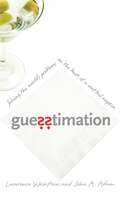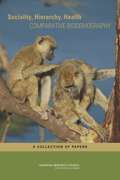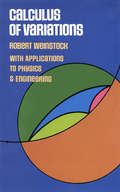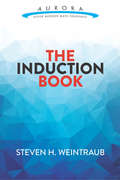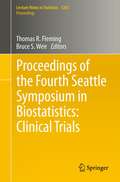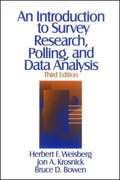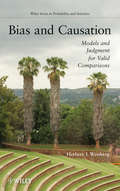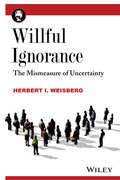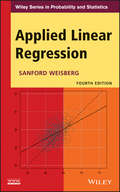- Table View
- List View
Creating Target Publics for Welfare Policies: A Comparative And Multi-level Approach (Logic, Argumentation And Reasoning Ser. #17)
by Pierre-Edouard Weill Lorenzo Barrault-StellaThis volume analyzes welfare policies by looking at the making of their target publics. It examines how these populations are identified and constructed by policy making. The contributors apply the classic theoretical question about who gets what, when, and how, but also suggest the revisiting of policy-feedback analysis. Coverage includes empirical case studies in different geographical areas. It looks at Europe, the United States and also considers Mayotte, set in a post-colonial context. The chapters also examine different aspects of welfare, including the bureaucratic treatment of marginalized populations as well as the middle class.The authors draw on diverse conceptual approaches and investigative methodologies. They conduct participant observation in public or nonprofit organizations, explore administrative records, and interview actors at various stages of policymaking. This qualitative material is then combined with relevant quantitative data.Readers are guided through a multilevel approach of welfare policies, from their definition to their implementation. They gain insight into the targeting of publics, from the higher reaches of government to the most underprivileged groups of the social world. Overall, the book compares different national contexts and social policy fields. This approach unearths regularities, enabling the authors to reassess major contemporary transformations of the welfare State.
Methods in Experimental Economics: An Introduction (Springer Texts in Business and Economics)
by Joachim Weimann Jeannette Brosig-KochThis textbook provides a hands-on and intuitive overview of the methodological foundations of experimental economics. Experimental economic research has been an integral part of economic science for quite some time and is gaining more and more attention in related disciplines. The book addresses the design and execution of experiments, the evaluation of experimental data and the equipment of an experimental laboratory. It illustrates the challenges involved in designing and conducting experiments and helps the reader to address them in practice.
Mastering Python for Finance
by James Ma WeimingIf you are an undergraduate or graduate student, a beginner to algorithmic development and research, or a software developer in the financial industry who is interested in using Python for quantitative methods in finance, this is the book for you. It would be helpful to have a bit of familiarity with basic Python usage, but no prior experience is required.
Mastering Python for Finance: Implement advanced state-of-the-art financial statistical applications using Python, 2nd Edition
by James Ma WeimingTake your financial skills to the next level by mastering cutting-edge mathematical and statistical financial applicationsKey FeaturesExplore advanced financial models used by the industry and ways of solving them using PythonBuild state-of-the-art infrastructure for modeling, visualization, trading, and moreEmpower your financial applications by applying machine learning and deep learningBook DescriptionThe second edition of Mastering Python for Finance will guide you through carrying out complex financial calculations practiced in the industry of finance by using next-generation methodologies. You will master the Python ecosystem by leveraging publicly available tools to successfully perform research studies and modeling, and learn to manage risks with the help of advanced examples.You will start by setting up your Jupyter notebook to implement the tasks throughout the book. You will learn to make efficient and powerful data-driven financial decisions using popular libraries such as TensorFlow, Keras, Numpy, SciPy, and sklearn. You will also learn how to build financial applications by mastering concepts such as stocks, options, interest rates and their derivatives, and risk analytics using computational methods. With these foundations, you will learn to apply statistical analysis to time series data, and understand how time series data is useful for implementing an event-driven backtesting system and for working with high-frequency data in building an algorithmic trading platform. Finally, you will explore machine learning and deep learning techniques that are applied in finance.By the end of this book, you will be able to apply Python to different paradigms in the financial industry and perform efficient data analysis.What you will learnSolve linear and nonlinear models representing various financial problemsPerform principal component analysis on the DOW index and its componentsAnalyze, predict, and forecast stationary and non-stationary time series processesCreate an event-driven backtesting tool and measure your strategiesBuild a high-frequency algorithmic trading platform with PythonReplicate the CBOT VIX index with SPX options for studying VIX-based strategiesPerform regression-based and classification-based machine learning tasks for predictionUse TensorFlow and Keras in deep learning neural network architectureWho this book is forIf you are a financial or data analyst or a software developer in the financial industry who is interested in using advanced Python techniques for quantitative methods in finance, this is the book you need! You will also find this book useful if you want to extend the functionalities of your existing financial applications by using smart machine learning techniques. Prior experience in Python is required.
Statistics for Social Workers (Ninth Edition)
by Robert W. Weinbach Richard M. GrinnellThis book intends to be a reference for social work practitioners who, increasingly, are involved in agency-based research projects, and who must critically evaluate the reports of research findings in order to remain effective evidence-based practitioners.
The Millennial Generation: Implications for the Intelligence and Policy Communities
by Cortney Weinbaum Jenny Oberholtzer Richard S. GirvenIn 2015, for the first time, millennials outnumbered baby boomers as the largest generational segment of the U.S. population. This report describes how the intelligence community must engage millennials across multiple segments to succeed in the future: millennials as intelligence clients, employees, and partners and as members of the public.
Radar Detection Theory of Sliding Window Processes
by Graham WeinbergConstant false alarm rate detection processes are important in radar signal processing. Such detection strategies are used as an alternative to optimal Neyman-Pearson based decision rules, since they can be implemented as a sliding window process running on a radar range-Doppler map. This book examines the development of such detectors in a modern framework. With a particular focus on high resolution X-band maritime surveillance radar, recent approaches are outlined and examined. Performance is assessed when the detectors are run in real X-band radar clutter. The book introduces relevant mathematical tools to allow the reader to understand the development, and follow its implementation.
Statistics Using Stata
by Weinberg Sharon Lawner Abramowitz Sarah KnappEngaging and accessible to students from a wide variety of mathematical backgrounds, Statistics Using Stata combines the teaching of statistical concepts with the acquisition of the popular Stata software package. It closely aligns Stata commands with numerous examples based on real data, enabling students to develop a deep understanding of statistics in a way that reflects statistical practice. Capitalizing on the fact that Stata has both a menu-driven 'point and click' and program syntax interface, the text guides students effectively from the comfortable 'point and click' environment to the beginnings of statistical programming. Its comprehensive coverage of essential topics gives instructors flexibility in curriculum planning and provides students with more advanced material to prepare them for future work. Online resources - including complete solutions to exercises, PowerPoint slides, and Stata syntax (do-files) for each chapter - allow students to review independently and adapt codes to solve new problems, reinforcing their programming skills.
Statistics Using IBM SPSS: An Integrative Approach
by Sharon Lawner Weinberg Sarah Knapp AbramowitzWritten in a clear and lively tone, Statistics Using IBM SPSS provides a data-centric approach to statistics with integrated SPSS (version 22) commands, ensuring that students gain both a deep conceptual understanding of statistics and practical facility with the leading statistical software package. With 100 worked examples, the textbook guides students through statistical practice using real data and avoids complicated mathematics. Numerous end-of-chapter exercises allow students to apply and test their understanding of chapter topics, with detailed answers available online. The third edition has been updated throughout and includes a new chapter on research design, new topics (including weighted mean, resampling with the bootstrap, the role of the syntax file in workflow management, and regression to the mean), and new examples and exercises. Student learning is supported by a rich suite of online resources, including answers to end-of-chapter exercises, real data sets, PowerPoint slides, and a test bank. Avoids calculus and linear algebra and instead grounds concepts in real data examples to ensure simple and clear explanation. Written by highly experienced teachers. Chapter examples and exercises are based on real data, which enables students to understand what it truly means to be a data analys.
A First Course in Partial Differential Equations: with Complex Variables and Transform Methods
by H. F. WeinbergerThis popular text was created for a one-year undergraduate course or beginning graduate course in partial differential equations, including the elementary theory of complex variables. It employs a framework in which the general properties of partial differential equations, such as characteristics, domains of independence, and maximum principles, can be clearly seen. The only prerequisite is a good course in calculus.Incorporating many of the techniques of applied mathematics, the book also contains most of the concepts of rigorous analysis usually found in a course in advanced calculus. These techniques and concepts are presented in a setting where their need is clear and their application immediate. Chapters I through IV cover the one-dimensional wave equation, linear second-order partial differential equations in two variables, some properties of elliptic and parabolic equations and separation of variables, and Fourier series. Chapters V through VIII address nonhomogeneous problems, problems in higher dimensions and multiple Fourier series, Sturm-Liouville theory, and general Fourier expansions and analytic functions of a complex variable. The last four chapters are devoted to the evaluation of integrals by complex variable methods, solutions based on the Fourier and Laplace transforms, and numerical approximation methods. Numerous exercises are included throughout the text, with solutions at the back.
Fast Compact Algorithms and Software for Spline Smoothing
by Howard L. WeinertFast Compact Algorithms and Software for Spline Smoothing investigates algorithmic alternatives for computing cubic smoothing splines when the amount of smoothing is determined automatically by minimizing the generalized cross-validation score. These algorithms are based on Cholesky factorization, QR factorization, or the fast Fourier transform. All algorithms are implemented in MATLAB and are compared based on speed, memory use, and accuracy. An overall best algorithm is identified, which allows very large data sets to be processed quickly on a personal computer.
Statistische Hypothesentests: Bausteine der Künstlichen Intelligenz (essentials)
by Siegfried WeinmannDieses Essential führt über die formale Methode des statistischen Entscheidens hinaus und klärt die Frage, mit welcher Gewissheit der Ausgang eines Tests ein Problem lösen kann. Wer sich in kurzer Zeit ein Grundverständnis der Beurteilenden Statistik erwerben will, kommt an diesem Buch nicht vorbei. Es setzt am Ursprung der Stichprobentheorie an, erklärt die Bayes-Evidenzmaße des Hypothesentests und diskutiert ihre Wirksamkeit an allgemeingültigen Fällen. Der Stoff des Essentials bildet einen wissenschaftlichen Pfad zur Künstlichen Intelligenz, der dem Leser in origineller Weise den objektorientierten Entwurf eines künstlichen Entscheidungsagenten darlegt und Einblicke in den Bau von Softwarekomponenten bietet.
Geometrical Vectors (Chicago Lectures In Physics Ser.)
by Gabriel WeinreichEvery advanced undergraduate and graduate student of physics must master the concepts of vectors and vector analysis. Yet most books cover this topic by merely repeating the introductory-level treatment based on a limited algebraic or analytic view of the subject. <P><P> Geometrical Vectors introduces a more sophisticated approach, which not only brings together many loose ends of the traditional treatment, but also leads directly into the practical use of vectors in general curvilinear coordinates by carefully separating those relationships which are topologically invariant from those which are not. Based on the essentially geometric nature of the subject, this approach builds consistently on students' prior knowledge and geometrical intuition. <P><P> Written in an informal and personal style, Geometrical Vectors provides a handy guide for any student of vector analysis. Clear, carefully constructed line drawings illustrate key points in the text, and problem sets as well as physical examples are provided.
Geometrical Vectors (Chicago Lectures in Physics)
by Gabriel WeinreichEvery advanced undergraduate and graduate student of physics must master the concepts of vectors and vector analysis. Yet most books cover this topic by merely repeating the introductory-level treatment based on a limited algebraic or analytic view of the subject.Geometrical Vectors introduces a more sophisticated approach, which not only brings together many loose ends of the traditional treatment, but also leads directly into the practical use of vectors in general curvilinear coordinates by carefully separating those relationships which are topologically invariant from those which are not. Based on the essentially geometric nature of the subject, this approach builds consistently on students' prior knowledge and geometrical intuition. Written in an informal and personal style, Geometrical Vectors provides a handy guide for any student of vector analysis. Clear, carefully constructed line drawings illustrate key points in the text, and problem sets as well as physical examples are provided.
Guesstimation 2.0: Solving Today's Problems on the Back of a Napkin
by Lawrence WeinsteinSimple and effective techniques for quickly estimating virtually anythingGuesstimation 2.0 reveals the simple and effective techniques needed to estimate virtually anything—quickly—and illustrates them using an eclectic array of problems. A stimulating follow-up to Guesstimation, this is the must-have book for anyone preparing for a job interview in technology or finance, where more and more leading businesses test applicants using estimation questions just like these.The ability to guesstimate on your feet is an essential skill to have in today's world, whether you're trying to distinguish between a billion-dollar subsidy and a trillion-dollar stimulus, a megawatt wind turbine and a gigawatt nuclear plant, or parts-per-million and parts-per-billion contaminants. Lawrence Weinstein begins with a concise tutorial on how to solve these kinds of order of magnitude problems, and then invites readers to have a go themselves. The book features dozens of problems along with helpful hints and easy-to-understand solutions. It also includes appendixes containing useful formulas and more.Guesstimation 2.0 shows how to estimate everything from how closely you can orbit a neutron star without being pulled apart by gravity, to the fuel used to transport your food from the farm to the store, to the total length of all toilet paper used in the United States. It also enables readers to answer, once and for all, the most asked environmental question of our day: paper or plastic?
Guesstimation: Solving the World's Problems on the Back of a Cocktail Napkin
by Lawrence Weinstein John AdamGuesstimation is a book that unlocks the power of approximation--it's popular mathematics rounded to the nearest power of ten! The ability to estimate is an important skill in daily life. More and more leading businesses today use estimation questions in interviews to test applicants' abilities to think on their feet. Guesstimation enables anyone with basic math and science skills to estimate virtually anything--quickly--using plausible assumptions and elementary arithmetic. Lawrence Weinstein and John Adam present an eclectic array of estimation problems that range from devilishly simple to quite sophisticated and from serious real-world concerns to downright silly ones. How long would it take a running faucet to fill the inverted dome of the Capitol? What is the total length of all the pickles consumed in the US in one year? What are the relative merits of internal-combustion and electric cars, of coal and nuclear energy? The problems are marvelously diverse, yet the skills to solve them are the same. The authors show how easy it is to derive useful ballpark estimates by breaking complex problems into simpler, more manageable ones--and how there can be many paths to the right answer. The book is written in a question-and-answer format with lots of hints along the way. It includes a handy appendix summarizing the few formulas and basic science concepts needed, and its small size and French-fold design make it conveniently portable. Illustrated with humorous pen-and-ink sketches, Guesstimation will delight popular-math enthusiasts and is ideal for the classroom.
Sociality, Hierarchy, Health: Comparative Biodemography
by Maxine WeinsteinSociality, Hierarchy, Health: Comparative Biodemography is a collection of papers that examine cross-species comparisons of social environments with a focus on social behaviors along with social hierarchies and connections, to examine their effects on health, longevity, and life histories. This report covers a broad spectrum of nonhuman animals, exploring a variety of measures of position in social hierarchies and social networks, drawing links among these factors to health outcomes and trajectories, and comparing them to those in humans. Sociality, Hierarchy, Health revisits both the theoretical underpinnings of biodemography and the empirical findings that have emerged over the past two decades.
Calculus of Variations (Dover Books on Mathematics)
by Robert WeinstockThis book by Robert Weinstock was written to fill the need for a basic introduction to the calculus of variations. Simply and easily written, with an emphasis on the applications of this calculus, it has long been a standard reference of physicists, engineers, and applied mathematicians. The author begins slowly, introducing the reader to the calculus of variations, and supplying lists of essential formulae and derivations. Later chapters cover isoperimetric problems, geometrical optics, Fermat's principle, dynamics of particles, the Sturm-Liouville eigenvalue-eigenfunction problem, the theory of elasticity, quantum mechanics, and electrostatics. Each chapter ends with a series of exercises which should prove very useful in determining whether the material in that chapter has been thoroughly grasped.The clarity of exposition makes this book easily accessible to anyone who has mastered first-year calculus with some exposure to ordinary differential equations. Physicists and engineers who find variational methods evasive at times will find this book particularly helpful. "I regard this as a very useful book which I shall refer to frequently in the future." J. L. Synge, Bulletin of the American Mathematical Society.
The Induction Book
by Steven H. WeintraubMathematical induction — along with its equivalents, complete induction and well-ordering, and its immediate consequence, the pigeonhole principle — constitute essential proof techniques. Every mathematician is familiar with mathematical induction, and every student of mathematics requires a grasp of its concepts. This volume provides an introduction and a thorough exposure to these proof techniques. Geared toward students of mathematics at all levels, the text is particularly suitable for courses in mathematical induction, theorem-proving, and problem-solving. The treatment begins with both intuitive and formal explanations of mathematical induction and its equivalents. The next chapter presents many problems consisting of results to be proved by induction, with solutions omitted to enable instructors to assign them to students. Problems vary in difficulty; the majority of them require little background, and the most advanced involve calculus or linear algebra. The final chapter features proofs too complicated for students to find on their own, some of which are famous theorems by well-known mathematicians. For these beautiful and important theorems, the author provides expositions and proofs. The text concludes with a helpful Appendix providing the logical equivalence of the various forms of induction.
Grundlagen des parallelen wissenschaftlichen Rechnens: Ein erster Leitfaden zu numerischen Konzepten und Programmiermethoden
by Tobias WeinzierlNeue Erkenntnisse in vielen wissenschaftlichen und technischen Bereichen sind ohne den Einsatz numerischer Simulationen, die auf modernen Computern effizient ablaufen, nicht denkbar. Je schneller wir neue Ergebnisse erhalten, desto größer und genauer sind die Probleme, die wir lösen können. Es ist die Kombination aus mathematischen Ideen und effizienter Programmierung, die den Fortschritt in vielen Disziplinen vorantreibt. Zukünftige Meister auf diesem Gebiet müssen daher in ihrem Anwendungsgebiet qualifiziert sein, sie brauchen ein tiefes Verständnis einiger mathematischer Ideen und sie müssen die Fähigkeiten haben, schnellen Code zu liefern.Das vorliegende Lehrbuch richtet sich an Studierende, die bereits über Programmierkenntnisse verfügen und die Mathematik nicht scheuen, auch wenn sie eine Ausbildung in Informatik oder einem Anwendungsbereich haben. Es führt in die grundlegenden Konzepte und Ideen hinter der angewandten Mathematik und der parallelen Programmierung ein,die wir brauchen, um numerische Simulationen für die heutigen Multicore-Workstations zu schreiben. Unsere Absicht ist es nicht, in einen bestimmten Anwendungsbereich einzutauchen oder eine neue Programmiersprache einzuführen - wir legen die allgemeinen Grundlagen für zukünftige Kurse und Projekte in diesem Bereich.Der Text ist in einem zugänglichen Stil geschrieben, der auch für Studenten ohne jahrelange Mathematikausbildung leicht zu verstehen ist. Er legt mehr Wert auf Klarheit und Intuition als auf Formalismus und verwendet eine einfache N-Körper-Simulation zur Veranschaulichung grundlegender Ideen, die in verschiedenen Teilbereichen des wissenschaftlichen Rechnens von Bedeutung sind. Sein primäres Ziel ist es, theoretische und paradigmatische Ideen für Studierende im Grundstudium zugänglich zu machen und die Faszination des Fachgebiets zu vermitteln.
Proceedings of the Fourth Seattle Symposium in Biostatistics: Clinical Trials
by Bruce S. Weir Thomas R. FlemingThis volume contains a selection of chapters base on papers presented at the Fourth Seattle Symposium in Biostatistics: Clinical Trials. The symposium was held in 2010 to celebrate the 40th anniversary of the University of Washington School of Public Health and Community Medicine. It featured keynote lectures by David DeMets and Susan Ellenberg and 16 invited presentations by other prominent researchers. The papers contained in this volume encompass recent methodological advances in several important clinical trials research, such as biomarkers, meta-analyses, sequential and adaptive clinical trials, and various genetic bioinformatic techniques. This volume will be a valuable reference for researchers and practitioners in the field of clinical trials.
An Introduction to Survey Research, Polling, and Data Analysis (3rd edition)
by Herbert F. Weisberg Jon A. Krosnick Bruce D. BowenExplains how surveys are conducted, how to read statistical reports, and how to analyze data, and provides guidelines for evaluating polls. Coverage includes understanding tables, interval statistics, survey design, sampling and question-writing, interviewing and coding strategies, analysis of different types of surveys, and reading and writing reports. Includes chapter exercises and answers. Paper edition (unseen), $25. 95. Annotation c. by Book News, Inc. , Portland, Or.
Bias and Causation
by Herbert I. WeisbergA one-of-a-kind resource on identifying and dealing with bias in statistical research on causal effects Do cell phones cause cancer? Can a new curriculum increase student achievement? Determining what the real causes of such problems are, and how powerful their effects may be, are central issues in research across various fields of study. Some researchers are highly skeptical of drawing causal conclusions except in tightly controlled randomized experiments, while others discount the threats posed by different sources of bias, even in less rigorous observational studies. Bias and Causation presents a complete treatment of the subject, organizing and clarifying the diverse types of biases into a conceptual framework. The book treats various sources of bias in comparative studies--both randomized and observational--and offers guidance on how they should be addressed by researchers. Utilizing a relatively simple mathematical approach, the author develops a theory of bias that outlines the essential nature of the problem and identifies the various sources of bias that are encountered in modern research. The book begins with an introduction to the study of causal inference and the related concepts and terminology. Next, an overview is provided of the methodological issues at the core of the difficulties posed by bias. Subsequent chapters explain the concepts of selection bias, confounding, intermediate causal factors, and information bias along with the distortion of a causal effect that can result when the exposure and/or the outcome is measured with error. The book concludes with a new classification of twenty general sources of bias and practical advice on how mathematical modeling and expert judgment can be combined to achieve the most credible causal conclusions. Throughout the book, examples from the fields of medicine, public policy, and education are incorporated into the presentation of various topics. In addition, six detailed case studies illustrate concrete examples of the significance of biases in everyday research. Requiring only a basic understanding of statistics and probability theory, Bias and Causation is an excellent supplement for courses on research methods and applied statistics at the upper-undergraduate and graduate level. It is also a valuable reference for practicing researchers and methodologists in various fields of study who work with statistical data. This book was selected as the 2011 Ziegel Prize Winner in Technometrics for the best book reviewed by the journal. It is also the winner of the 2010 PROSE Award for Mathematics from The American Publishers Awards for Professional and Scholarly Excellence
Willful Ignorance
by Herbert I. WeisbergAn original account of willful ignorance and how this principle relates to modern probability and statistical methods Through a series of colorful stories about great thinkers and the problems they chose to solve, the author traces the historical evolution of probability and explains how statistical methods have helped to propel scientific research. However, the past success of statistics has depended on vast, deliberate simplifications amounting to willful ignorance, and this very success now threatens future advances in medicine, the social sciences, and other fields. Limitations of existing methods result in frequent reversals of scientific findings and recommendations, to the consternation of both scientists and the lay public.Willful Ignorance: The Mismeasure of Uncertainty exposes the fallacy of regarding probability as the full measure of our uncertainty. The book explains how statistical methodology, though enormously productive and influential over the past century, is approaching a crisis. The deep and troubling divide between qualitative and quantitative modes of research, and between research and practice, are reflections of this underlying problem. The author outlines a path toward the re-engineering of data analysis to help close these gaps and accelerate scientific discovery. Willful Ignorance: The Mismeasure of Uncertainty presents essential information and novel ideas that should be of interest to anyone concerned about the future of scientific research. The book is especially pertinent for professionals in statistics and related fields, including practicing and research clinicians, biomedical and social science researchers, business leaders, and policy-makers.
Applied Linear Regression
by Sanford WeisbergPraise for the Third Edition"...this is an excellent book which could easily be used as a course text..."--International Statistical InstituteThe Fourth Edition of Applied Linear Regression provides a thorough update of the basic theory and methodology of linear regression modeling. Demonstrating the practical applications of linear regression analysis techniques, the Fourth Edition uses interesting, real-world exercises and examples.Stressing central concepts such as model building, understanding parameters, assessing fit and reliability, and drawing conclusions, the new edition illustrates how to develop estimation, confidence, and testing procedures primarily through the use of least squares regression. While maintaining the accessible appeal of each previous edition,Applied Linear Regression, Fourth Edition features:Graphical methods stressed in the initial exploratory phase, analysis phase, and summarization phase of an analysisIn-depth coverage of parameter estimates in both simple and complex models, transformations, and regression diagnosticsNewly added material on topics including testing, ANOVA, and variance assumptionsUpdated methodology, such as bootstrapping, cross-validation binomial and Poisson regression, and modern model selection methodsApplied Linear Regression, Fourth Edition is an excellent textbook for upper-undergraduate and graduate-level students, as well as an appropriate reference guide for practitioners and applied statisticians in engineering, business administration, economics, and the social sciences.
